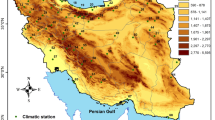Abstract
Using the data observed by 62 Chinese Routine Meteorological Stations (CRMS) with long term radiation observation, the climatic trends and the relationship between pan-evaporation and its environmental factors are analyzed comprehensively. The results show that during the last 40 years, the relative humidity is uptrend in west China, downtrend in east China, and their extrema are 0.20%/a and −0.22 %/a respectively; the precipitations of about 61% CRMS keep uptrend, its maximum can reach 10.52 mm/a2 while the cloud amounts of about 79% CRMS keep downtrend slightly. About 98% CRMS display the air temperature uptrend, and the maximum is 0.11 °C/a. About 76% CRMS display the land surface temperature uptrend. About 87% CRMS show the daily range of temperature downtrend. The global radiations observed by about 85% CRMS and the 10 m wind speeds observed by about 77% CRMS hold downtrend. The annual pan-evaporations of about 66% CRMS hold descend trend, and the biggest descent reaches −24.9 mm/a2. The pan-evaporation has good relationship with many environmental factors, but the relationship with the relative humidity is the best. All of the climatic trends respond to the global climate changes.
Similar content being viewed by others
References
Ohmura, A., Wild, M., Is the hydrological cycle accelerating? Science, 2002, 298: 1345–1346.
IPCC, Climate Change 2001: The Scientific Basis, Contribution of Working Group I to the Third Assessment Report of the International Panel on Climate Change (ed. Houghton, J. T.), Cambridge, New York: Cambridge Univ. Press, 2001, 193–227.
Ye, D. Z., Study on global change and sustainable development in China, Advances in Earth Science (in Chinese), 1999, 14: 317–318.
Yao, T. D., Xu, B. Q., Pu, J. C., Climatic changes on orbital and sub-orbital time scale recorded by the Guliya ice core in Tibetan Plateau, Science in China, Ser. D, 2001, 31: 287–294.
Peterson, T. C., Golubev, V. S., Groisman, P. Y., Evaporation losing its strength, Nature, 1995, 377: 687–688.
Brutsaert, W., Parlange, M. B., Hydrological cycle explain the evaporation paradox, Nature, 1998, 396: 30–31.
Roderick, M. L., Farquar, G. D., The cause of decreased pan evaporation over the past 50 years, Science, 2002, 298: 1410–1411.
Cohen, S., Stanhill, G., Evaporative climate changes at Bet-Dagan, Israel, 1964–1998, Agricultural and Forest Meteorology, 2002, 111: 83–91.
Stanhill, G., Cohen, S., Global dimming: A review of the evidence for a widespread and significant reduction in global radiation with discussion of its probale causes and posiible agricultural consequences, Agricutural and Forest Meteorology, 2001, 107: 255–278.
Chattoopadhyay, N., Hulme, M., Evaporation and potential evapotransoiration in India under conditions of recent and future climate change, Agricultural and Forest Meteorology, 1997, 87: 55–72.
Qiu, X. F., Liu, C. M., Ceng, Y., Changes of pan evaporation in the recent 40 years over the Yellow River basin, Journal of Natural Resource (in Chinese), 2003, 18: 437–441.
Ramanathan, V., Crutzen, P. J., Kiehl, J. T., Aerosols, climate, and the hydrological cycle, Science, 2001, 294: 2119–2124.
Thomas, A., Spatial and temporal characteristics of potential evapotranspiration trends over China, International Journal of Climatology, 2000, 20: 381–396.
China Meteorological Bureau, The Regulation of Surface Meteorological Observation (in Chinese), Beijing: China Meteorological Press, 2003, 11–79.
Fu, C. B., Dong, W. J., Wen, G. et al., Regional response and adaptation to global change, Acta Meteorological Sinica (in Chinese), 2003, 61: 245–250.
Wang, S. W., Gong, D. Y., Study on climate change in China, Climatic and Environmental Research (in Chinese), 2002, 7: 137–145.
Shi, Y. F., Shen, Y. B., Hu, R. J., Preliminary study on signal, impact and foreground of climate shift from warm-dry to warm-humid in Northwest China, Journal of Glaciology and Geochryology (in Chinese), 2002, 24: 219–226.
Zuo, H. C., Lü, S. H., Hu, Y. Q., Variations trend of yearly mean air temperature precipitation in China in the last 50 years, Plateau Meteorology (in Chinese), 2004, 23: 238–244.
Huang, Y. X., Li, D. L., Wang, B. J. et al., Analyses on temperature spatial features of annual precipitation in Northwest China in 1961–2000, Plateau Meteorology (in Chinese), 2004, 23: 245–252.
Zuo, H. C., Hu, Y. Q., The bulk transfer coefficient over desert and gobi in Heihe region, Plateau Meteorology (in Chinese), 1992, 11: 371–380.
Zhong, H. L., Li, D. L., Relationship between sand-dust storm formation in April and westerly circulation, Plateau Meteorology (in Chinese), 2005, 24: 104–111.
Author information
Authors and Affiliations
Corresponding author
About this article
Cite this article
Zuo, H., Li, D., Hu, Y. et al. Characteristics of climatic trends and correlation between pan-evaporation and environmental factors in the last 40 years over China. Chin.Sci.Bull. 50, 1235–1241 (2005). https://doi.org/10.1007/BF03183699
Received:
Accepted:
Issue Date:
DOI: https://doi.org/10.1007/BF03183699




